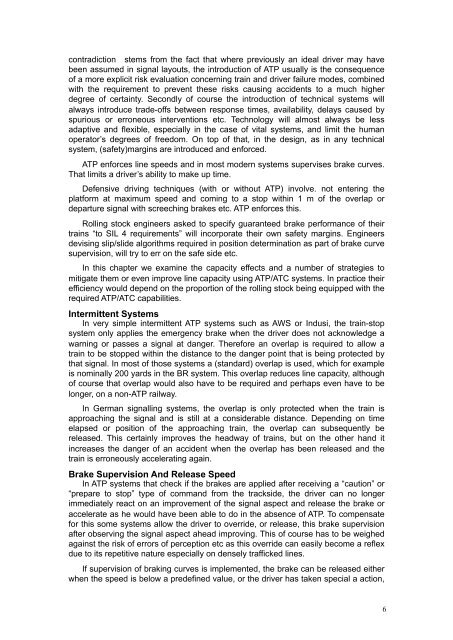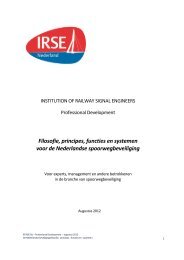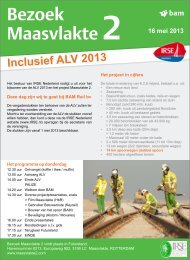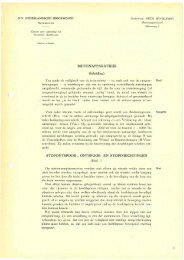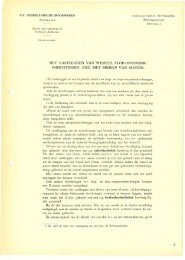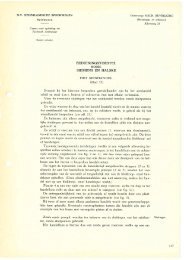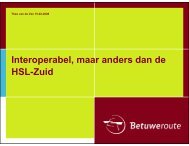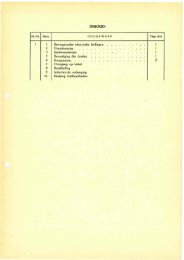intermittent and continuous ATP 101119 - irse.nl
intermittent and continuous ATP 101119 - irse.nl
intermittent and continuous ATP 101119 - irse.nl
- No tags were found...
You also want an ePaper? Increase the reach of your titles
YUMPU automatically turns print PDFs into web optimized ePapers that Google loves.
contradiction stems from the fact that where previously an ideal driver may havebeen assumed in signal layouts, the introduction of <strong>ATP</strong> usually is the consequenceof a more explicit risk evaluation concerning train <strong>and</strong> driver failure modes, combinedwith the requirement to prevent these risks causing accidents to a much higherdegree of certainty. Secondly of course the introduction of technical systems willalways introduce trade-offs between response times, availability, delays caused byspurious or erroneous interventions etc. Technology will almost always be lessadaptive <strong>and</strong> flexible, especially in the case of vital systems, <strong>and</strong> limit the humanoperator’s degrees of freedom. On top of that, in the design, as in any technicalsystem, (safety)margins are introduced <strong>and</strong> enforced.<strong>ATP</strong> enforces line speeds <strong>and</strong> in most modern systems supervises brake curves.That limits a driver’s ability to make up time.Defensive driving techniques (with or without <strong>ATP</strong>) involve. not entering theplatform at maximum speed <strong>and</strong> coming to a stop within 1 m of the overlap ordeparture signal with screeching brakes etc. <strong>ATP</strong> enforces this.Rolling stock engineers asked to specify guaranteed brake performance of theirtrains “to SIL 4 requirements” will incorporate their own safety margins. Engineersdevising slip/slide algorithms required in position determination as part of brake curvesupervision, will try to err on the safe side etc.In this chapter we examine the capacity effects <strong>and</strong> a number of strategies tomitigate them or even improve line capacity using <strong>ATP</strong>/ATC systems. In practice theirefficiency would depend on the proportion of the rolling stock being equipped with therequired <strong>ATP</strong>/ATC capabilities.Intermittent SystemsIn very simple <strong>intermittent</strong> <strong>ATP</strong> systems such as AWS or Indusi, the train-stopsystem o<strong>nl</strong>y applies the emergency brake when the driver does not acknowledge awarning or passes a signal at danger. Therefore an overlap is required to allow atrain to be stopped within the distance to the danger point that is being protected bythat signal. In most of those systems a (st<strong>and</strong>ard) overlap is used, which for exampleis nominally 200 yards in the BR system. This overlap reduces line capacity, althoughof course that overlap would also have to be required <strong>and</strong> perhaps even have to belonger, on a non-<strong>ATP</strong> railway.In German signalling systems, the overlap is o<strong>nl</strong>y protected when the train isapproaching the signal <strong>and</strong> is still at a considerable distance. Depending on timeelapsed or position of the approaching train, the overlap can subsequently bereleased. This certai<strong>nl</strong>y improves the headway of trains, but on the other h<strong>and</strong> itincreases the danger of an accident when the overlap has been released <strong>and</strong> thetrain is erroneously accelerating again.Brake Supervision And Release SpeedIn <strong>ATP</strong> systems that check if the brakes are applied after receiving a “caution” or“prepare to stop” type of comm<strong>and</strong> from the trackside, the driver can no longerimmediately react on an improvement of the signal aspect <strong>and</strong> release the brake oraccelerate as he would have been able to do in the absence of <strong>ATP</strong>. To compensatefor this some systems allow the driver to override, or release, this brake supervisionafter observing the signal aspect ahead improving. This of course has to be weighedagainst the risk of errors of perception etc as this override can easily become a reflexdue to its repetitive nature especially on densely trafficked lines.If supervision of braking curves is implemented, the brake can be released eitherwhen the speed is below a predefined value, or the driver has taken special a action,6


